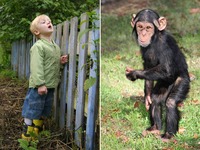As the father-to-son exchange in the old Cat Stevens song advised, "take your time, think a lot, ... think ofeverything you’ve got."

Synaptic division.Compared with chimpanzees, human children slowly wire their brains. Credit: Fotosearch |
Turns out the mellow '70s folkie had stumbled upon what may explain a key feature of our brains that sets us apart from our closest relatives: We unhurriedly make synaptic connections through much of our early childhoods, and this plasticity enables us to slowly wire our brains based on our experiences. Given that humans and chimpanzees share 98.8% of the same genes, researchers have long wondered what drives our unique cognitive and social skills. Yes, chimpanzees are smart and cooperative to a degree, but we clearly outshine them when it comes to abstract thinking, self-regulation, assimilation of cultural knowledge, and reasoning abilities. Now a study that looks at postmortem brain samples from humans, chimpanzees, and macaques collected from before birth to up to the end of the life span for each of these species has found a key difference in the expression of genes that control the development and function of synapses, the connections among neurons through which information flows.
As researchers describe in a report published online today in Genome Research, they analyzed the expression of some 12,000 genes—part of the so-called transcriptome—from each species. They found 702 genes in the prefrontal cortex (PFC) of humans that had a pattern of expression over time that differed from the two other species. (The PFC plays a central role in social behavior, working toward goals, and reasoning.) By comparison, genes in the chimpanzee PFC at various life stages had only 55 unique expression patterns—12-fold fewer than found in humans.
The genes the researchers analyzed have myriad functions. But when the researchers created five modules that lumped together genes that were co-expressed, they found that the module in humans that’s most closely tied to synapse formation and function had a “drastically” different developmental trajectory. These genes were turned on high from just after birth until about 5 years of age; the same genes in chimpanzees and macaques began to stop expressing themselves shortly after birth. “We might have discovered one of the differences that makes human brains work differently from chimpanzees and macaques,” says lead researcher Philipp Khaitovich, an evolutionary biologist who works at both the Max Planck Institute for Evolutionary Anthropology in Leipzig, Germany, and the Chinese Academy of Sciences (CAS) in Shanghai, China.
The researchers, including Svante Pääbo of the Leipzig institute and Xiling Liu of CAS, went a step further and actually counted more than 7000 synapses visible in electron micrographs from the three species at different ages. They found that the number of synapses in macaques and chimpanzees skyrocketed shortly after birth but did not peak in humans until about 4 years of age. “Humans have much more time to form synaptic connections,” Khaitovich concludes.
In their analyses, the researchers factored in that humans have much longer life spans than the other species and develop and mature more slowly in general. Their findings still stood out, even when adjusting for this developmental delay.
The work builds on behavioral evidence that showed the advantages of a prolonged childhood, as well as several other studies that have found differences in chimpanzee and human genes involved with synapse formation and function. But no group has ever done such a thorough comparative, longitudinal analysis of the brain transciptomes of these three species, says Todd Preuss, a neuroscientist at the Yerkes National Primate Research Center in Atlanta. “The whole thing is a technical tour de force,” Preuss says.
Nenad Sestan, a neurobiologist at Yale University who published a comprehensive analysis of the transcriptome of human brains from embryos to late adulthood in the 27 October 2011 issue of Nature, says the new work “is novel and provocative.” Sestan says to clarify differences between the species, the field now needs to examine more brain regions “to have a clearer idea of how specific this may be to the dorsolateral prefrontal cortex.”
The findings from Khaitovich and colleagues promise to spark future studies that address profound questions about everything from evolution to gene regulation. For example, they suggest in their report that the differences they found may also separate us from Neandertals, as evidence suggests that these extinct humans had faster cranial and dental development than modern humans.
Neurologist Eric Courchesne of the University of California, San Diego, says the new findings also mesh with his own studies of autism and brain overgrowth. Courchesne has found that the brains of autistic children grow more quickly than normal, which he theorizes prevents them from having enough experiences to properly wire neurons. “This is an absolutely fascinating study that will have great importance for advancing understanding of human disorders of early brain development as well as illuminating the evolutionary changes in neural development,” Courchesne says.
(Source: Science)